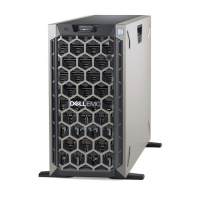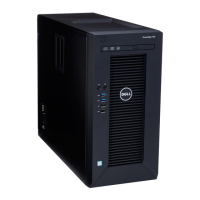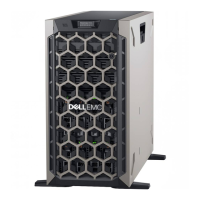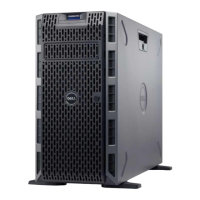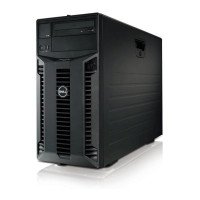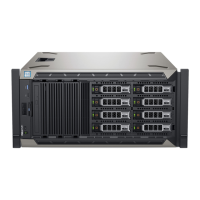Do you have a question about the Dell PowerEdge T630 and is the answer not in the manual?
Details the various supported hardware configurations for the PowerEdge T630 server, including processor, memory, and storage options.
Describes the components and connectors located on the front panel of the server, including buttons, slots, and indicators.
Details the components and connectors located on the back panel of the server, including ports and power supplies.
Explains the meaning of various diagnostic indicators on the server for system status and error reporting.
Provides prerequisites and steps for preparing the server system for conversion from tower mode to rack mode.
Lists available documentation resources for system setup, configuration, and management, with links to Dell support.
Provides detailed physical dimensions and weight specifications for the Dell PowerEdge T630 system.
Details specifications for processors, power supply units (PSUs), including heat dissipation and voltage.
Outlines specifications for system memory modules and supported hard drive types and configurations.
Describes the various ports and connectors available on the system, including USB, VGA, and serial ports.
Details environmental requirements such as temperature, humidity, vibration, and contamination limits.
Provides a step-by-step guide for initial system setup, including unpacking, connecting, and powering on.
Explains how to configure and log in to the iDRAC for remote system management.
Guides on installing the operating system and downloading necessary drivers and firmware.
Describes how to access and navigate the System Setup utility for BIOS and device configuration.
Details the options available within the System BIOS for configuring boot order, passwords, and devices.
Explains how to configure boot modes (BIOS/UEFI) and manage the boot sequence for the system.
Covers system security settings, including passwords, TPM, and secure boot configurations.
Guides on how to enter and use the Boot Manager for selecting boot options and utilities.
Provides essential safety instructions and prerequisites before working inside the system.
Details procedures for installing and removing various system components like bezels, feet, and covers.
Provides instructions for installing and reseating system memory modules (DIMMs).
Guides on removing and installing hard drives, SSDs, and drive blanks, including hot-swap procedures.
Details the steps for removing and installing processors and heat sinks, including thermal grease application.
Explains how to remove and install AC and DC power supply units (PSUs) and manage PSU features.
Provides instructions for removing and installing the system board, including component handling.
Details how to run system diagnostics using Boot Manager or Lifecycle Controller for hardware assessment.
Explains the menus and descriptions for controlling and viewing system diagnostic results.
Identifies and describes system board connectors for components and cables.
Explains the function and settings of system board jumpers, including password management.
Provides steps to disable or clear system and setup passwords using the system board jumper.
Addresses issues related to system startup failures and external connection problems.
Guides on resolving issues with the video subsystem and connected USB devices.
Provides steps for troubleshooting network interface cards (NICs), serial devices, and wet system issues.
Covers common problems related to system memory, power supply units, and cooling systems.
Provides information on how to contact Dell support for assistance, including online and phone options.
Explains how to use the Quick Resource Locator (QRL) for accessing system information and support.
Details the various supported hardware configurations for the PowerEdge T630 server, including processor, memory, and storage options.
Describes the components and connectors located on the front panel of the server, including buttons, slots, and indicators.
Details the components and connectors located on the back panel of the server, including ports and power supplies.
Explains the meaning of various diagnostic indicators on the server for system status and error reporting.
Provides prerequisites and steps for preparing the server system for conversion from tower mode to rack mode.
Lists available documentation resources for system setup, configuration, and management, with links to Dell support.
Provides detailed physical dimensions and weight specifications for the Dell PowerEdge T630 system.
Details specifications for processors, power supply units (PSUs), including heat dissipation and voltage.
Outlines specifications for system memory modules and supported hard drive types and configurations.
Describes the various ports and connectors available on the system, including USB, VGA, and serial ports.
Details environmental requirements such as temperature, humidity, vibration, and contamination limits.
Provides a step-by-step guide for initial system setup, including unpacking, connecting, and powering on.
Explains how to configure and log in to the iDRAC for remote system management.
Guides on installing the operating system and downloading necessary drivers and firmware.
Describes how to access and navigate the System Setup utility for BIOS and device configuration.
Details the options available within the System BIOS for configuring boot order, passwords, and devices.
Explains how to configure boot modes (BIOS/UEFI) and manage the boot sequence for the system.
Covers system security settings, including passwords, TPM, and secure boot configurations.
Guides on how to enter and use the Boot Manager for selecting boot options and utilities.
Provides essential safety instructions and prerequisites before working inside the system.
Details procedures for installing and removing various system components like bezels, feet, and covers.
Provides instructions for installing and reseating system memory modules (DIMMs).
Guides on removing and installing hard drives, SSDs, and drive blanks, including hot-swap procedures.
Details the steps for removing and installing processors and heat sinks, including thermal grease application.
Explains how to remove and install AC and DC power supply units (PSUs) and manage PSU features.
Provides instructions for removing and installing the system board, including component handling.
Details how to run system diagnostics using Boot Manager or Lifecycle Controller for hardware assessment.
Explains the menus and descriptions for controlling and viewing system diagnostic results.
Identifies and describes system board connectors for components and cables.
Explains the function and settings of system board jumpers, including password management.
Provides steps to disable or clear system and setup passwords using the system board jumper.
Addresses issues related to system startup failures and external connection problems.
Guides on resolving issues with the video subsystem and connected USB devices.
Provides steps for troubleshooting network interface cards (NICs), serial devices, and wet system issues.
Covers common problems related to system memory, power supply units, and cooling systems.
Provides information on how to contact Dell support for assistance, including online and phone options.
Explains how to use the Quick Resource Locator (QRL) for accessing system information and support.
| Tcase | 72.1 °C |
|---|---|
| Bus type | QPI |
| Stepping | R2 |
| Scalability | 2S |
| Processor code | SR206 |
| Processor cache | 20 MB |
| Processor cores | 8 |
| Processor model | E5-2630V3 |
| System bus rate | 8 GT/s |
| Processor series | Intel Xeon E5-2600 v3 |
| Processor socket | LGA 2011-v3 |
| Processor threads | 16 |
| Processor codename | Haswell |
| Execute Disable Bit | Yes |
| Motherboard chipset | Intel C610 |
| Processor frequency | 2.4 GHz |
| Processor cache type | Smart Cache |
| Processor lithography | 22 nm |
| Processor manufacturer | Intel |
| Processor package size | 52.5 x 45 mm |
| Processor front side bus | - MHz |
| Processor boost frequency | 3.2 GHz |
| Processor operating modes | 64-bit |
| Embedded options available | No |
| Supported instruction sets | AVX |
| Thermal Design Power (TDP) | 85 W |
| Number of processors installed | 2 |
| Maximum number of PCI Express lanes | 40 |
| Memory types supported by processor | DDR4-SDRAM |
| Memory channels supported by processor | Quad |
| Memory clock speeds supported by processor | 1600, 1866 MHz |
| Memory bandwidth supported by processor (max) | 59 GB/s |
| Maximum internal memory supported by processor | 768 GB |
| On-board graphics card model | Not available |
| HDD size | 3.5 \ |
| HDD speed | 7200 RPM |
| HDD capacity | 1000 GB |
| HDD interface | Serial ATA III |
| Optical drive type | DVD±RW |
| Total storage capacity | 2000 GB |
| Maximum storage capacity | - TB |
| Supported storage drive interfaces | PCI Express, SAS, Serial ATA |
| Memory slots | 24 |
| Internal memory | 16 GB |
| Memory clock speed | 2400 MHz |
| Maximum internal memory | 1536 GB |
| Memory layout (slots x size) | 2 x 8 GB |
| Cabling technology | 10/100/1000Base-T(X) |
| Ethernet interface type | Gigabit Ethernet |
| USB 2.0 ports quantity | - |
| PCI Express slots version | 3.0 |
| PCI Express x16 (Gen 3.x) slots | 4 |
| Compatible operating systems | Microsoft Windows Server 2008/2012 R2 Microsoft Windows Server 2008/2012 R2 SP2 Novell SUSE Linux Enterprise Server Red Hat Enterprise Linux |
| Chassis type | Tower (5U) |
| Power supply | 750 W |
| Processor ARK ID | 83356 |
| Intel Secure Key Technology version | 1.00 |
| Intel Identity Protection Technology version | 0.00 |
| Depth | 750.9 mm |
|---|---|
| Width | 482 mm |
| Height | - mm |


